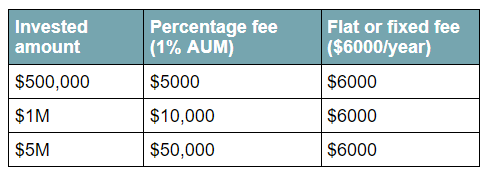
“How much does a financial advisor make?”
It’s a question we hear often and for good reason — the answer doesn’t seem as clear-cut as you think.
You’re aware that financial advisors don’t work for free. However, the fee structure in the financial management industry can be confusing at times. Luckily, transparency became more regulated within Canada between 2014 and 2016. Even with greater transparency, there’s still a lot of variation in how financial advisors make their money and charge fees.
Here is a breakdown of the fee structure that fee-for-service financial planners use.
This form of fee is charged as a percentage of the assets under management (AUM). It’s usually between 1-2% annually. A Management Expense Ration (MER) would fall under this category.
In this case, a fee is earned for the financial advisor regardless of their performance. The better the assets perform, the more they can make as a manager or advisor.
A fixed-fee financial planner charges a set amount of money for portfolio management rather than a percentage or commission. This form of compensation can be a better fit for many investors as you don’t end up paying more of your gains in percentage-based fees. However, it can also mean paying a high fee when your investments aren’t performing well. See the below table for an example of the difference in annual costs associated with these types of fees.

Unlike an ongoing fee-only financial planner model, an advisor may opt to charge a one-time fee to set up an entire financial plan or for a particular project. In many cases, the ongoing management of a fund will still cost an investor either a flat-fee percentage or a fixed fee.
Some financial planners charge by the hour for portfolio management and advice. However, they’re not charging you $100-$400/hour for 40 hours a week. You’ll only be charged when they’re doing work on your portfolio or offering advice. The issue with this model is that they may put more time in some months, meaning you don’t have a fixed amount each month. This fee structure is commonly only seen for special projects or one-time services rather than ongoing management.
The classic fee-for-service financial planner refers to a 2 and 20 principle for a fund manager. Investors will be charged 2% of the managed assets and 20% based on a performance mark. The classic fee has evolved to be a lower management fee and higher performance fee, meaning investors are motivated to create higher-performing funds. Still, it ultimately costs the investor a lot more than public market funds (such as ETFs) or many alternative investment types.

If you’re a relatively new investor, it’s essential to look into lower fees or even robo-advisors that often have low fees under 1% AUM. If, however, you’re a savvy investor looking for alternative investments outside of the funds managed and suggested by your fee-for-service financial planner, mortgage pools through a mortgage investment corporation (MIC) may be the perfect alternative investment for your portfolio. At Cooper Pacific, we don’t have any fees, including in our registered plans. Other MIC firms like ours use outside Trustees for their registered plans, but at Cooper Pacific, we cover all fees (transfer, withdrawal, annual, etc.). To learn more, get in touch with Jordan on our team today.